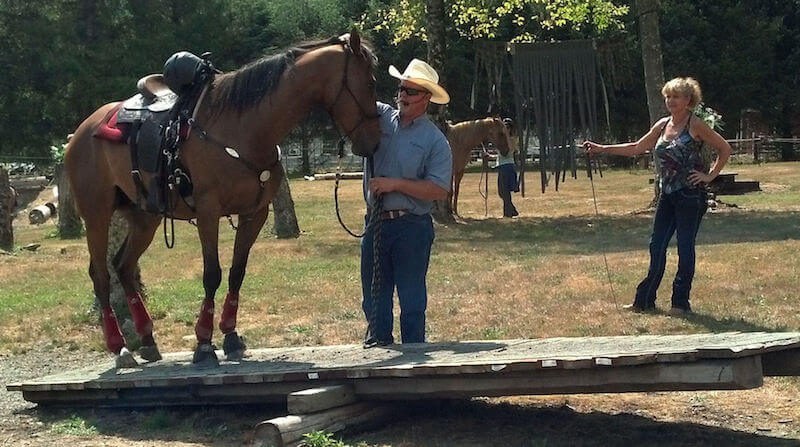Steady Your Horse’s Emotions with Calm Energy
by Marilyn Pineda, Fire Mountain Trail Course

I recently went out on a trail ride with one of my visitors here at Fire Mountain Trail Course and we stopped for a rest in the shade by the creek on our way back. We had dismounted and were standing there chatting when my mare Gemma suddenly jolted sideways. She swung her hip around to look behind her, thus startling the visiting gelding. Thinking of Raye Lochert, I calmly gathered Gemma back up and continued in conversation. My visitor had done the same with her horse, offering no acknowledgement of the spontaneous reaction of the two horses. Gemma kept her ears up and alert in the direction of whatever it was she thought to be so scary, but we ignored her.
This exact sort of scenario had been discussed during the workshop we had earlier that day: using calm energy to bring horses down to a safe level of emotion. I don’t know what set Gemma off. It could have been the fluttering of fencing tape in the breeze, or something in the brush behind us. What spooked her doesn’t matter. What was important in that moment is that Gemma and the gelding easily returned to their relaxed state of mind and brought their attention back to us.
What did Raye Lochert have to do with this? We recently had the opportunity to host Raye and his wife Sharon here at Fire Mountain Trail Course and I was impressed with the number of times we saw the dramatic results of calm energy. It sounds simple, but is often difficult to execute in a moment of stress. Calm energy is worth practicing, however. It is the most effective tool for calming a spooked horse or bringing an excitable horse down to a lower level of energy and emotion.
Participants in Raye’s clinic included several horses that were noticeably anxious. How could we tell? By heads turning, feet moving, tails flagging and ears swirling in every direction. These were the first horses Ray would take in-hand to demonstrate techniques that facilitated cooperation from anxious horses, including something as basic as being led with a loose lead line. Raye’s solution to the uptight condition of these horses was to remain calm and, even, downright boring while staying consistent in his expectation of behavior.
Let’s look more in depth at the basic of leading on a loose line: Instead of raising your own energy to “get after” your horse if he crowds or passes you, simply stop and take hold of the rope near his chin and firmly back him up to proper—and safe— position. Allow slack in the lead again and continue on your walk. Do this as often as necessary to keep your horse behind you on a loose lead. Refrain from chastising him with hard jerks, or bopping him under his chin with the clip at the end of your rope as this will most likely cause him to lift his head as far as possible as he backs up in order to avoid the discomfort of your reprimand. As Raye pointed out, a high headed horse is the last thing you want to be encouraging!
Keeping a low energy profile and using consistent understandable correction with a friendly attitude will allow your horse to follow your lead in all sorts of situations. It will take a little extra time in the beginning, but it will become easier as he learns to give better attention to you resulting in his energy coming down. He will become a willing partner, and you will move forward in your journey to riding well grounded!
Published October 2013 Issue

The Colorado Horse Source is an independently owned and operated print and online magazine for horse owners and enthusiasts of all breeds and disciplines in Colorado and surrounding area. Our contemporary editorial columns are predominantly written by experts in the region, covering the care, training, keeping and enjoyment of horses, with an eye to the specific concerns in our region.

